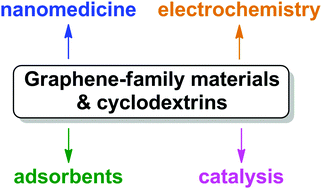Recent developments in the synthesis and applications of graphene-family materials functionalized with cyclodextrins
Abstract
The introduction of cyclodextrin species to graphene-family materials (GFMs) constitutes an important area of research, especially in terms of the development of applied nanoscience. The chemistry of cyclodextrins is the so-called host–guest chemistry, which has impacted on many fields of research, including catalysis, electrochemistry and nanomedicine. Cyclodextrins are water-soluble and biocompatible supramolecules, and therefore they may introduce new interesting properties to GFMs and may enhance the physicochemical/biological features of native GFMs. The reported methods for the conjugation of cyclodextrins to GFMs utilize either covalent or non-covalent approaches. The recent progress in the applications of GFMs functionalized with cyclodextrins, with the respect to the chemistry and features of these conjugates, is discussed. Special consideration is also given to the recent developments in (i) nanomedicine, (ii) electrochemistry, (iii) adsorption and (iv) catalysis. Examples of these materials are discussed in this work, together with the future outlook on the impact of GFM–cyclodextrin conjugates in the development of applied nanoscience.



 Please wait while we load your content...
Please wait while we load your content...